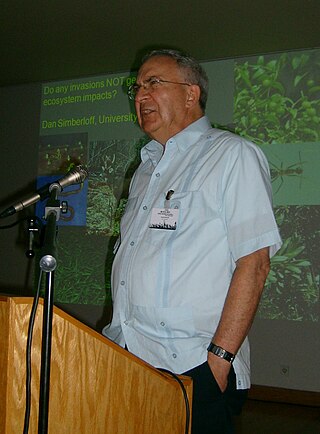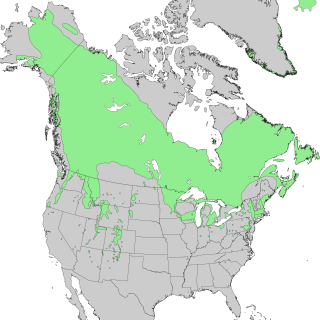Related Research Articles

Ecology is the natural science of the relationships among living organisms and their environment. Ecology considers organisms at the individual, population, community, ecosystem, and biosphere levels. Ecology overlaps with the closely related sciences of biogeography, evolutionary biology, genetics, ethology, and natural history.

Theoretical ecology is the scientific discipline devoted to the study of ecological systems using theoretical methods such as simple conceptual models, mathematical models, computational simulations, and advanced data analysis. Effective models improve understanding of the natural world by revealing how the dynamics of species populations are often based on fundamental biological conditions and processes. Further, the field aims to unify a diverse range of empirical observations by assuming that common, mechanistic processes generate observable phenomena across species and ecological environments. Based on biologically realistic assumptions, theoretical ecologists are able to uncover novel, non-intuitive insights about natural processes. Theoretical results are often verified by empirical and observational studies, revealing the power of theoretical methods in both predicting and understanding the noisy, diverse biological world.

A herbivore is an animal anatomically and physiologically evolved to feed on plants, especially upon vascular tissues such as foliage, fruits or seeds, as the main component of its diet. These more broadly also encompass animals that eat non-vascular autotrophs such as mosses, algae and lichens, but do not include those feeding on decomposed plant matters or macrofungi.

Predation is a biological interaction where one organism, the predator, kills and eats another organism, its prey. It is one of a family of common feeding behaviours that includes parasitism and micropredation and parasitoidism. It is distinct from scavenging on dead prey, though many predators also scavenge; it overlaps with herbivory, as seed predators and destructive frugivores are predators.

In ecology, a niche is the match of a species to a specific environmental condition. It describes how an organism or population responds to the distribution of resources and competitors and how it in turn alters those same factors. "The type and number of variables comprising the dimensions of an environmental niche vary from one species to another [and] the relative importance of particular environmental variables for a species may vary according to the geographic and biotic contexts".
Population dynamics is the type of mathematics used to model and study the size and age composition of populations as dynamical systems.

Population ecology is a sub-field of ecology that deals with the dynamics of species populations and how these populations interact with the environment, such as birth and death rates, and by immigration and emigration.

In ecology, an ecosystem is said to possess ecological stability if it is capable of returning to its equilibrium state after a perturbation or does not experience unexpected large changes in its characteristics across time. Although the terms community stability and ecological stability are sometimes used interchangeably, community stability refers only to the characteristics of communities. It is possible for an ecosystem or a community to be stable in some of their properties and unstable in others. For example, a vegetation community in response to a drought might conserve biomass but lose biodiversity.
Spatial ecology studies the ultimate distributional or spatial unit occupied by a species. In a particular habitat shared by several species, each of the species is usually confined to its own microhabitat or spatial niche because two species in the same general territory cannot usually occupy the same ecological niche for any significant length of time.

Daniel Simberloff is an American biologist and ecologist. He earned his Ph.D. from Harvard University in 1969. He is currently Gore Hunger Professor of Environmental Science at the University of Tennessee, editor-in-chief of the journal Biological Invasions, and a member of the National Academy of Sciences.

Robert Helmer MacArthur was a Canadian-born American ecologist who made a major impact on many areas of community and population ecology. He is considered to be one of the founders of ecology.
A mixed model, mixed-effects model or mixed error-component model is a statistical model containing both fixed effects and random effects. These models are useful in a wide variety of disciplines in the physical, biological and social sciences. They are particularly useful in settings where repeated measurements are made on the same statistical units, or where measurements are made on clusters of related statistical units. Mixed models are often preferred over traditional analysis of variance regression models because they don't rely on the independent observations assumption. Further, they have their flexibility in dealing with missing values and uneven spacing of repeated measurements. The Mixed model analysis allows measurements to be explicitly modeled in a wider variety of correlation and variance-covariance avoiding biased estimations structures.

Species distribution, or speciesdispersion, is the manner in which a biological taxon is spatially arranged. The geographic limits of a particular taxon's distribution is its range, often represented as shaded areas on a map. Patterns of distribution change depending on the scale at which they are viewed, from the arrangement of individuals within a small family unit, to patterns within a population, or the distribution of the entire species as a whole (range). Species distribution is not to be confused with dispersal, which is the movement of individuals away from their region of origin or from a population center of high density.
Ecological traps are scenarios in which rapid environmental change leads organisms to prefer to settle in poor-quality habitats. The concept stems from the idea that organisms that are actively selecting habitat must rely on environmental cues to help them identify high-quality habitat. If either the habitat quality or the cue changes so that one does not reliably indicate the other, organisms may be lured into poor-quality habitat.
Shayle Robert Searle PhD was a New Zealand mathematician who was professor emeritus of biological statistics at Cornell University. He was a leader in the field of linear and mixed models in statistics, and published widely on the topics of linear models, mixed models, and variance component estimation.
William W. Murdoch is a Charles A. Storke II professor of population ecology at the University of California, Santa Barbara. Over the years, his research has focused primarily on the subjects of population regulation, predator–prey dynamics, and biological control. He has also contributed extensively to understanding the scientific and socioeconomic ramifications caused by human overpopulation and environmental degradation. He was the recipient of the 1990 Robert H. MacArthur Award granted by the Ecological Society of America. He is a member of the National Academy of Sciences (NAS), the American Association for the Advancement of Science (AAAS), and the Ecological Society of America (ESA).
Graeme James Caughley was a New Zealand population ecologist, conservation biologist, and researcher. He combined empirical research with mathematical models, and supported the declining population paradigm.
In ecology, a priority effect refers to the impact that a particular species can have on community development as a result of its prior arrival at a site. There are two basic types of priority effects: inhibitory and facilitative. An inhibitory priority effect occurs when a species that arrives first at a site negatively affects a species that arrives later by reducing the availability of space or resources. In contrast, a facilitative priority effect occurs when a species that arrives first at a site alters abiotic or biotic conditions in ways that positively affect a species that arrives later. Inhibitory priority effects have been documented more frequently than facilitative priority effects. Studies indicate that both abiotic and biotic factors can affect the strength of priority effects.. Priority effects are a central and pervasive element of ecological community development that have significant implications for natural systems and ecological restoration efforts.
In macroecology and community ecology, an occupancy frequency distribution (OFD) is the distribution of the numbers of species occupying different numbers of areas. It was first reported in 1918 by the Danish botanist Christen C. Raunkiær in his study on plant communities. The OFD is also known as the species-range size distribution in literature.
Frederick Ernest Joseph Fry was a Canadian ichthyologist and aquatic ecologist. He is known for his early research in physiological ecology and population dynamics in fishes. In the late 1940s, he became the first scientist to model how environmental factors affect the activity of fish. He was a 1959 Guggenheim Fellow, and served as president of several organizations including the American Society of Limnology and Oceanography (1951) American Fisheries Society (1966) and American Institute of Fishery Research Biologists (1972).
References
- ↑ "Obituary: G. Lefort 1921-1979". Biometrics. 36 (3). International Biometric Society: 557–559. JSTOR 2530230.
- ↑ Christopher Morris (27 July 2009). "Milestones in Ecology". In Simon A. Levin; Stephen R. Carpenter; H. Charles J. Godfray; Ann P. Kinzig; Michel Loreau; Jonathan B. Losos; Brian Walker; David S. Wilcove (eds.). The Princeton Guide to Ecology (PDF). Princeton University Press.
- ↑ Tom Robbins; Mark Lewis. "Biological Invasions in Heterogeneous Environments" (PDF). Archived from the original (PDF) on 25 February 2007.
- ↑ Strickland, A.H. (1957). "Insects and Insect Ecology". New Scientist. 3: 17–20.